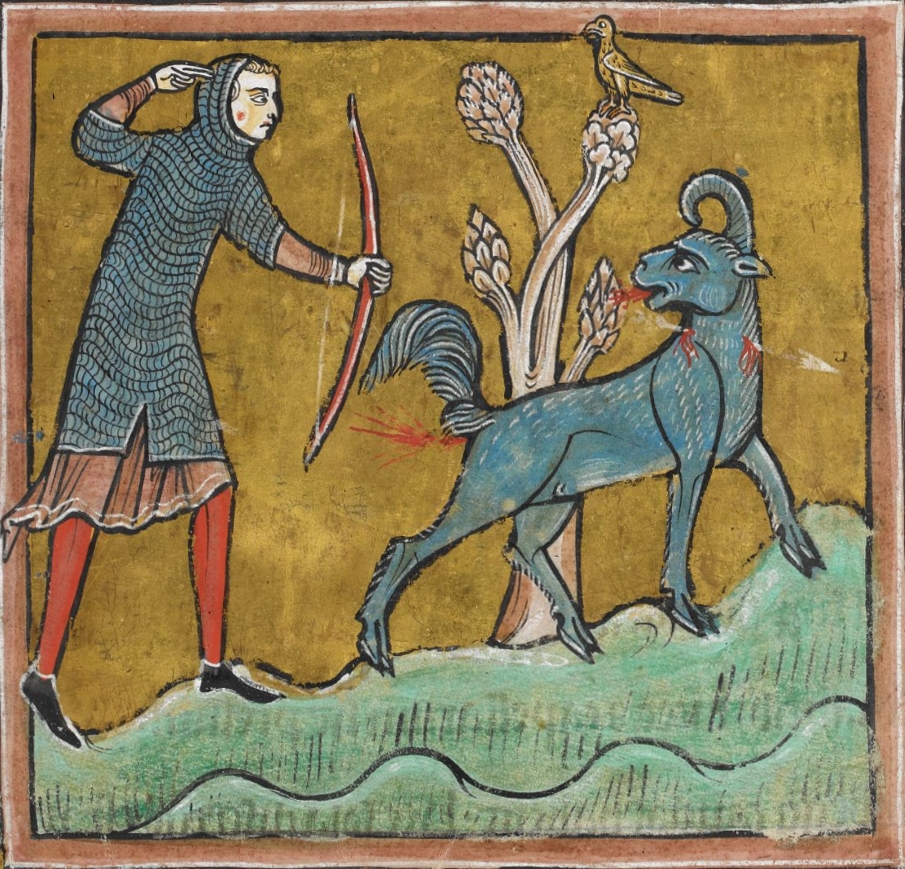Bonnacon on:
[Wikipedia]
[Google]
[Amazon]
 The bonnacon (also called bonasus or bonacho) is a legendary creature described as a
The bonnacon (also called bonasus or bonacho) is a legendary creature described as a
Bonnacon at The Medieval Bestiary
Image of the Bonnacon in the fifteenth-century English bestiary Copenhagen, GKS 1633 4º, f. 10r
Legendary mammals Medieval European legendary creatures Defecation
 The bonnacon (also called bonasus or bonacho) is a legendary creature described as a
The bonnacon (also called bonasus or bonacho) is a legendary creature described as a bull
A bull is an intact (i.e., not castrated) adult male of the species ''Bos taurus'' (cattle). More muscular and aggressive than the females of the same species (i.e., cows), bulls have long been an important symbol in many religions,
includin ...
with inward-curving horns and a horse-like mane. Medieval
In the history of Europe, the Middle Ages or medieval period lasted approximately from the late 5th to the late 15th centuries, similar to the post-classical period of global history. It began with the fall of the Western Roman Empire ...
bestiaries
A bestiary (from ''bestiarum vocabulum'') is a compendium of beasts. Originating in the ancient world, bestiaries were made popular in the Middle Ages in illustrated volumes that described various animals and even rocks. The natural history ...
usually depict its fur as reddish-brown or black. Because its horns were useless for self-defense, the bonnacon was said to expel large amounts of caustic feces from its anus at its pursuers, burning them and thereby ensuring its escape.
Textual history
The first known description of the bonnacon comes fromPliny the Elder
Gaius Plinius Secundus (AD 23/2479), called Pliny the Elder (), was a Roman author, naturalist and natural philosopher, and naval and army commander of the early Roman Empire, and a friend of the emperor Vespasian. He wrote the encyclopedic ' ...
's ''Naturalis Historia
The ''Natural History'' ( la, Naturalis historia) is a work by Pliny the Elder. The largest single work to have survived from the Roman Empire to the modern day, the ''Natural History'' compiles information gleaned from other ancient authors. ...
'':
The term is derived from Greek βόνᾱσος (''bonasos''), meaning " bison".
The popularity of the ''Naturalis Historia'' in the Middle Ages led to the bonnacon's inclusion in medieval bestiaries. In the tradition of the ''Physiologus
The ''Physiologus'' () is a didactic Christian text written or compiled in Greek by an unknown author, in Alexandria; its composition has been traditionally dated to the 2nd century AD by readers who saw parallels with writings of Clement of Al ...
'', bestiaries often ascribed moral and scriptural lessons to the descriptions of animals, but the bonnacon gained no such symbolic meaning. Manuscript illustrations of the creature may have served as a source of humor, deriving as much from the reaction of the hunters as from the act of defecation. The Aberdeen Bestiary
The ''Aberdeen Bestiary'' (Aberdeen University Library, Univ Lib. MS 24) is a 12th-century England, English illuminated manuscript bestiary that was first listed in 1542 in the inventory of the Old Royal Library at the Palace of Westminster. Du ...
describes the creature using similar language to Pliny, though the beast's location is moved from Paeonia to Asia
Asia (, ) is one of the world's most notable geographical regions, which is either considered a continent in its own right or a subcontinent of Eurasia, which shares the continental landmass of Afro-Eurasia with Africa. Asia covers an are ...
:
The bonnacon is also mentioned in the life of Saint Martha in the ''Golden Legend
The ''Golden Legend'' (Latin: ''Legenda aurea'' or ''Legenda sanctorum'') is a collection of hagiographies by Jacobus de Voragine that was widely read in late medieval Europe. More than a thousand manuscripts of the text have survived.Hilary ...
'', a 13th-century hagiographical
A hagiography (; ) is a biography of a saint or an ecclesiastical leader, as well as, by extension, an adulatory and idealized biography of a founder, saint, monk, nun or icon in any of the world's religions. Early Christian hagiographies mig ...
work by Jacobus de Voragine
Jacobus de Voragine (c. 123013/16 July 1298) was an Italian chronicler and archbishop of Genoa. He was the author, or more accurately the compiler, of the '' Golden Legend'', a collection of the legendary lives of the greater saints of the medi ...
. In the story, Saint Martha encounters and tames the Tarasque
The Tarasque is a fearsome legendary dragon-like mythological hybrid from Provence, in southern France, tamed in stories about Saint Martha, such as the one told in Jacobus de Voragine's '' Golden Legend'' (13th century).
The tarasque was des ...
, a dragon-like legendary creature said to be the offspring of the biblical Leviathan
Leviathan (; he, לִוְיָתָן, ) is a sea serpent noted in theology and mythology. It is referenced in several books of the Hebrew Bible, including Psalms, the Book of Job, the Book of Isaiah, the Book of Amos, and, according to some ...
and the bonnacon. In this account, the bonnacon (here: bonacho or onacho) is said to originate in Galatia.
References
External links
{{Commons category, Medieval miniatures of bonnaconBonnacon at The Medieval Bestiary
Image of the Bonnacon in the fifteenth-century English bestiary Copenhagen, GKS 1633 4º, f. 10r
Legendary mammals Medieval European legendary creatures Defecation